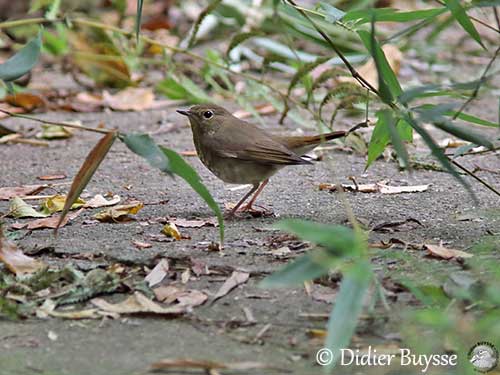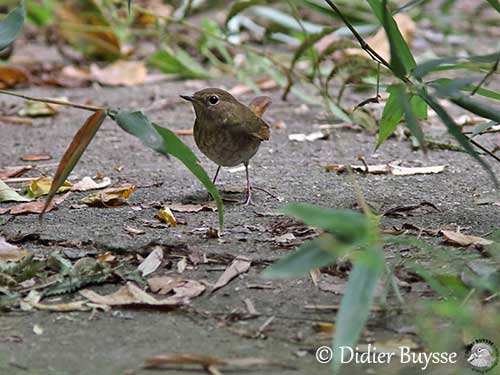
The breeding behaviour is poorly known. The male sings during the breeding season, usually during the day but also at night.
We can suggest that the bright rufous rump and tail play a role in courtship displays, when enhanced by adapted postures.
The Rufous-tailed Robin moves southwards after breeding, usually soon after the young are independent, in late August in Russia and some weeks later in Korea. They arrive near Hong Kong in November.
The return migration in Russia occurs in mid-May into early June.
Vagrants were recorded in Britain in 2004 (Shetland Islands), in Poland in 2005, in Norfolk in 2011 and in Denmark in 2012. It is also present in Alaska, and can be observed in Aleutian Islands, Pribilof Islands and St Paul.
The flight is swift and direct with rapid wingbeats.
REPRODUCTION OF THIS SPECIES:
The breeding season takes place between May and July, mainly June/July in Russia.
The nest is a cup-shaped structure placed in tree hole or on stump, usually near the ground but occasionally higher, up to 15 metres above the ground.
It is made with dry grass, leaves, moss and lichens, plant fibres, pine needles and decaying vegetation. It is lined with fine stems and rootlets.
The female lays 5-6 uniformly pale blue eggs, or bluish-grey with brown markings. No more information.
PROTECTION / THREATS / STATUS:
The Rufous-tailed Robin is usually fairly common throughout the large range.
The size of the population is unknown, but it is suspected to be stable.
The Rufous-tailed Robin is not considered globally threatened and currently evaluated as Least Concern.
Fr: Rossignol siffleur
Ang: Rufous-tailed Robin
All: Schwirrnachtigall
Esp: Ruiseñor Silbador
Ita: Usignolo di Swinhoe
Nd: Snornachtegaal
Sd: drillnäktergal
Photographer:
Didier Buysse
Vision d’Oiseaux
Text by Nicole Bouglouan
Sources:
HANDBOOK OF THE BIRDS OF THE WORLD Vol 10 by Josep del Hoyo-Andrew Elliott-David Christie - Lynx Edicions - ISBN: 8487334725
Robins and Chats Par Peter Clement – Editeur: Bloomsbury Publishing, 2016 – ISBN: 1408155966, 9781408155967 - 688 pages
A Field Guide to the Birds of South-East Asia by Craig Robson. New Holland Publishers. ISBN: 9781780090498
The Cornell Lab of Ornithology - Birds of the World
South Dakota Birds and Birding – (Terry L. Sohl)
SORA Searchable Ornithological Research Archive (Blair O. Wolf)
Wikipedia, the free encyclopaedia
Rufous-tailed Robin
Larvivora sibilans
Passeriformes Order – Muscicapidae Family
INTRODUCTION:
The Rufous-tailed Robin is a small passerine in the family Muscicapidae that breeds from C and E China to NE China, and winters in S and SE China to SE Asia.
It breeds in forests with dense undergrowth, from lowlands to 1,200 metres of elevation. During winter, it is mainly found in more lightly wooded areas and in urban parks and gardens. It feeds mainly on insects and other invertebrates, and often forages on the ground. The nest is a cup-shaped structure placed near the ground, in tree hole or on stump.
The Rufous-tailed Robin is described as fairly common throughout the range, and its population is stable. The species is not currently threatened.
DESCRIPTION OF THE BIRD:
Biometrics:
Length: 13-14 cm
The Rufous-tailed Robin has warm brown plumage on the upperparts, but rump, uppertail-coverts and tail are strongly rufescent. The flight-feathers are washed rufous.
The underparts are whitish. Chin and throat are tinged grey. Throat, breast and upper flanks show distinct brownish-grey scaling. Lower flanks are washed buff.
On the head, forehead, crown, nape and lores are brown. There is a preocular whitish supercilium and a buffy-white eyering. Cheeks and ear-coverts are brown with whitish mottling.
The bill is blackish to horn-brown, with paler base to mandible. The eyes are dark brown. Legs and feet are pinkish-brown.
Male and female are similar.

The juvenile resembles adult, but head and upperpart feathers show broad, pale buff/ochre-brown subterminal spots.
On the underparts, throat and breast show more diffuse scaling, with brownish centres to feathers.
RANGE:
The Rufous-tailed Robin breeds in C and E Siberia, E to S Russian Far East, N and C Sakhalin, C Kamchatka and NE China (possibly also S Kuril Islands and NE Korea).
It moves southwards after breeding to S and SE China, Hainan, Laos and N and C Vietnam.
HABITAT:
The Rufous-tailed Robin frequents forested habitats such as broadleaved evergreen and semi-evergreen forests with well-developed undergrowth, also conifer forest (mainly spruce-fir) with dense understorey, and wet, shady second growth. It breeds from plains and lowlands up to 1,200 metres of elevation.
During winter, it is found in forest, woodland and lightly wooded areas and also frequents urban parks and gardens.
CALLS AND SONGS: SOUNDS BY XENO-CANTO
The Rufous-tailed Robin gives soft, low “tuc-tuc” or “chok-chok” as contact call. When alarmed, it gives a thin whistle.
Two songs are known, given during the spring migration and on the breeding grounds.
The first song is a wavering, high-pitched whistle, accelerating before fading towards the end “tiu see-eeeee-sseeeee”.
The second song is described as chattering trills running down and up the scale and fading towards the end “t’t’t’t’t’r’r’r’r”. Some individuals may give longer trills with some variations “see ooo t’t’t’t’r’r’r’r’r”.
BEHAVIOUR IN THE WILD:
The Rufous-tailed Robin has mainly terrestrial habits and behaviour. This elusive bird is usually hidden among branches where it may remain for long periods.
It feeds primarily on insects including insect larvae, ants and beetles, also spiders and other invertebrates.
While foraging, it typically flicks the tail like numerous Muscicapidae. It searches for prey in the leaf litter and in the low, dense undergrowth. It moves by short hops in thrush-like action, and it also may walk with partly raised tail.
